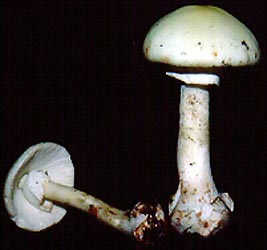|
[ Section Validae page. ]
[ Amanita Studies home. ]
[ Keys & Checklist/Picturebooks ] "White American Star-footed Amanita"
Technical description (t.b.d.) BRIEF DESCRIPTION: The following is based in large part on the original description by Singer (1959b). The entire fruiting body of A. aestivalis, slowly stains some shade of red-brown to brown (because of bruising, cutting, age, etc.). The cap is 54 - 83 mm wide, entirely white with the occasional exception of pale tan or pale yellow over the center, and ranges from parabolic-obtuse at first to convex to planar as it matures. The margin is nonstriate or very short striate and not appendiculate; sometimes it flares upward in age. The volva is usually absent from the cap, but sometimes may be present at first in thin, submembranous patches. The gills are free, close, white, subventricose, moderately broad, and with slightly fimbriate edges. Form of short gills was not originally reported. The stipe 90 - 160 x 6 - 16 mm, white, cylindric or narrowing upward, usually without notable decoration, and stuffed. The stipe bears a white, superior, persistent annulus. There is a broad (up to 33 mm or more wide), rather abrupt, vertically cleft bulb at the stipe's base. This bulb is sometimes marginate (with a fragile, thin, raised rim 1- 10 mm high that is often obliterated during expansion of the fruiting body). The spores measure (5.8-) 7.0 - 9.5 (-10.9) x (5.0-) 6.8 - 8.8 (-10.5) Ám and are globose to subglobose (occasionally broadly ellipsoid) and amyloid. Clamps are absent from bases of basidia. Singer stated the species occurred in forests of broad-leaved trees or in forests of such trees mixed with conifers. Among the associated trees, he listed beech, birch, fir, hemlock (Tsuga), oak, pine, and spruce. In my experience, the species is most commonly found in the northern hardwood-hemlock forests of the New England states in the USA, the southeastern provinces of Canada, and in the Appalachian mountain chain at least far enough south to include the Great Smoky Mountains National Park. The species was described from material collected in Massachusetts, Michigan, New York and Virginia, with the type taken from the Michigan material. Singer stated the species' range extended south to Florida. It is known from the eastern USA. Its segregation from A. asteropus Sabo ex Romagn. was demonstrated by Tulloss and Massart (1998). There is some question as to whether A. aestivalis is distinct from A. brunnescens G. F. Atk. Singer claimed that bruising/staining occurred more rapidly in A. brunnescens and that the radial lines of pigment often seen on the cap of the latter species are not ever to be found in A. aestivalis. -- R. E. Tulloss Photo: R. E. Tulloss (northeastern U.S.A.)
[ Section Validae page. ]
[ Amanita Studies home. ]
[ Keys & Checklist/Picturebooks ] Last changed 28 September 2009. |
